Part Two: Redefining the Stonehenge Landscape
Durrington Walls Pit Ring is by far the largest known example of a megalithic egg, when compared with other existing types of ‘egg’, such as Woodhenge (Type II, Thom, 1967), just south of Durrington; Allen Water, near Hawick,(Type I, Thom, 1967 ); and Castell Mawr henge in Pembrokeshire (Type III, Heath, 1916), adjacent to the ‘bluestone’ outcrops of Preseli, in West Wales. Other surviving examples of ‘Type III’ eggs, which have semi-elliptical ‘blunt’ ends, include Hirnant cairn circle in Montgomeryshire (Type III Hoyle, 1977), and Glasserton Mains rock art, on the Machan peninsula, Dumfries and Galloway (Morris and Bailey, 1967).
In Part One, the map of the pits around Durrington Walls was shown to clearly define the known geometry of a circular ended Type II egg, based on the locations of the many pits that make up the ‘pit ring’ discovery at Durrington. This geometry was compared with that of Castell Mawr.
Part Two shifts the focus to a metrological analysis of the shape of this pit ring, exploring its apparent properties and the relationship between Stonehenge and Durrington Walls pit ring , whose centre is located at a distance of just under 2 miles to the north-east of Stonehenge.
A New Circle around Stonehenge.
Stonehenge displays some similar qualities to the pit ring in that both monuments have identifiable centres and both have connections with megalithic constructions beyond their enclosing ‘walls’or ditch and bank, which extend out into the wider landscape. My earlier posts on Woodhenge provide a good example of such an extension to Stonehenge. Both monuments are also redolent with geometrical and metrological information, the kind of evidence that I routinely work with.
The investigation here identifies and quantifies these similarities, and concludes by identifying a possible further large circle, concentric to, but set well beyond the present boundaries of Stonehenge’s bluestone, sarsen and Aubrey circles, and analysis will suggest a highly significant underlying purpose for such a circle’s existence.
The Geometry and Metrology of Durrington Pit Ring
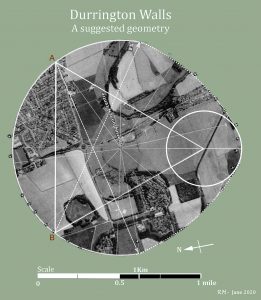
Diameter of the forming circle = 7,056ft, radius 3,528ft
Major axis = 7,056ft Major Axis =~7410ft [ratio 20:21]
Perimeter of circle (pi =22/7) = 22,176ft
Equilateral triangle arm lengths = 5,604ft
Circumference of egg = 23,195ft
Identifying the unit of length employed in monuments
My prime measurements at megalithic sites are recorded in feet. The SI metric system defines a drastically different system of weights and measures to those employed during pre-Napoleonic times. To record measures from a prehistoric site in metres invokes an unnecessary encoding process that obfuscates the metrological meaning or ‘message’ one is attempting to ‘read’. It makes any analysis that bit harder.
Prehistoric sites were designed and built using a far older system of measures. Very little is known about the origins of this system, nor when this integrated system originated. However, the foot appears as the standard unit of length from which the majority of most known measuring units in the ancient world were (fractionally) related. I have learnt to rely on measurements taken on site and I have found that the metrology of megalithic sites is best unlocked by initially measuring in units of feet.
Almost all of the other units of length – inch, cubit, remen, yard, fathom, rod, chain, furlong etc – are multiples of, or fractionally related, to the ‘English’ foot, which became the root measure of the presumed later ancient system of measures. In 1627, to further the ‘supremacy of the foot’, a ruler of this exact length was accurately engraved onto the wall of the King’s Chamber within the Great Pyramid by Oxford mathematician and geometer, professor John Greaves, who wrote underneath, ‘to be observed by all nations‘, and he duly signed it for all to see ever after. This astonishing endorsement of the foot measure, a wholly unexpected graffiti within the Great Pyramid, continues to offer sound advice to any would-be metrologist!
Nationalists we must disappoint by pointing out that the ‘English’ foot is no more English than is the ancient Greek foot from Greece. Both these units have been identified incorporated into ancient structures over much of the globe, while the Greek foot remains central to the modern world’s navigational systems. The recent work of John Neal (Ancient Metrology, vol I and II, 2016, Squeeze Press, et al) would give further reassurances on this matter. Another excellent source of metrological wisdom would be the renowned archaeologist and metrologist, the late Prof Livio Stecchini.
From data given within the archaeological report, the main circle at Durrington, whose semi-circle forms the minor axis of the pit’s geometrical design, has been determined to have a diameter of 7056ft, (1.337miles or 2.15Km, as the report indicates). The pit ring’s theoretical major axis is somewhere between 7410ft and 7565ft, (based on the minor axis being 7056ft) and the uncertain position of the ‘sharp end’ of the Pit rings egg shape is due to the lack of pits on this part of the perimeter. The internal ‘forming’ equilateral triangle has side lengths each of 5604ft.
An Unexpected Meeting with Plato
Are there any prehistoric metrological units suggested in the measures listed above? Yes, there are. A unit of 7ft has been identified in the main measures, such that one may confidently write that,
Diameter of the forming circle = 1,008 x 7 ft; radius 504 x 7 ft
Perimeter of forming circle (pi =22/7) = 3,168 x 7 ft
Equilateral triangle arm lengths = 800 x 7 ft
Circumference of pit ring = ~23,195ft = 3313.57 x 7ft
This introduces something quite radically different in its nature and implications. Using the 7ft measure is entirely legitimate, such a length is identified and better defined metrologically as being six ‘Russian‘ feet. The ‘Russian’ foot is 1.66..ft in length, nothing at all to do with Russia, apart from being first identified within ancient monuments there. The length is far better written down as a fraction, so that one ‘Russian’ foot = 7/6ths of an English foot).
Using 7 ft as the base unit, the perimeter and diameter of the Durrington Walls Pit Ring geometry are seen to conform perfectly to the traditional numerical qualities to be applied in the construction of a circular Temple, or of any sacred circular structure, conferring a value of 1008 units of 7 English feet (or 6 Russian feet) onto the diameter and 3168 of the same units to the corresponding circumference, precisely in accordance with Plato’s descriptions of temple design, given in Laws. That coincidence should raise a few eyebrows.
The Durrington pit ring predates Plato by two millenia, yet here are his recommended ‘temple’ numbers, 1008 and 3168, in quantised units of six Russian feet, conferring legitimacy on the structure being identified as a sacred temple. This is, of course, not the only example of this practice to be found on Salisbury Plain. In the 1960s, John Michell was revealing at Stonehenge that the mean diameter of the Sarsen lintel ring measured 100.8 ft and its mean circumference was 316.8ft. Typical John Michell – there first, as usual!
Without requiring any ‘recourse to the extremes of numerology‘, the archaeological report on the pit ring is seen to support a reasonable metrological connection to the geometry, stating (on page 36) that ‘The desire to maintain a notional geometry through the placement of these large pits is impressive and is presumably representative of the deeper concern with circular, bounded spaces that are evident elsewhere in the Neolithic and Bronze Age landscapes of Britain (Whittle 1997a, 147-8; Darvill 1997)’.
This is academic archaeology speak for ‘joining up the dots (pits) reveals a geometry which shows that the builders strove to attain a high accuracy in determining the shapes of their constructions.‘
The Suggested Astronomy of Durrington Pit Ring
Again, without ‘recourse to the extremes of numerology‘, it is remarkable that other data that supports the report’s commentary that,
‘it is conceivable that the act of pacing out a notional pattern on the ground might well have reinforced perceived cosmological linkages and these, in turn, may have been inscribed into the landscape through the massive pits found at Durrington‘.
I could not agree more, and here’s the reason. The designed perimeter of the pit ring, at 23,195ft is sufficiently accurately defined (worst case to within ±5 feet) to suggest an astronomical role or purpose for the design, for,
23195ft = lunar sidereal year x 12 megalithic fathoms (MFs).
The lunar sidereal month is 27.32167 (days) in duration. Thirteen of these sidereal months form the sidereal lunar year and take 355.18 days to complete, Astronomically, in 355.18 days, thirteen lunar orbits of the earth have taken place, each sidereal lunar month defined as the time between two consecutive transits of the moon past a fixed point (a pre-defined star) in the zodiac following the completion of one revolution around the zodiac. The megalithic fathom (see later) is 5.4432 feet in length. This is one heck of a ‘cosmological linkage‘!
It is therefore true that the measured perimeter of the Durrington Walls pit ring falls within 99.97% of representing the sidereal lunar year, where a unit of 12 megalithic fathoms (or paces) represents one day, such that,
355.18 (days) x 12 x 5.4432 (ft) = 23,199.9 (ft).
The Durrington Walls pit ring can therefore be used as a keeper or marker of lunar time, a role that has been long identified with other ‘egg’ monuments, whose major axes often have the ‘sharp end’ of the egg pointing at the horizon where the major (and sometimes the minor) standstill moonrise or set occurs. In this example, a length of 12 megalithic fathoms is taken to represent one day, as a length of time. There are 355.18 such day-lengths around the perimeter of the ring. The sidereal lunar year is enshrined in the length of the perimeter, in units of megalithic fathoms, this important astronomical constant is therefore enduringly stored within the monument’s structure.
It is useful to provide a further example of sidereal lunar observation at Stonehenge. Three sidereal months take almost 82 days to complete (the exact figure is 81.96 days). This means that, for an observational astronomer, every three months finds the moon passing past the same star at very nearly the same time of the day or night.
The pit ring egg has a perimeter of an estimated length of about 23,195ft. Divided this by 81.96 results in 283 ft, which divided by four megalithic fathoms of 5.4432ft ) is almost exactly 13. Now 283.6ft is the mean surveyed diameter of the Stonehenge Aubrey circle, a 56 marker circle from around 3000BC. The astronomer Professor Fred Hoyle first noted in modern times (1963) that the design recorded the daily position of the moon against the zodiacal stars and was capable of predicting eclipses.
Yards, Fathoms and Eggs
It took Alexander Thom thirty years to positively identify the length of the megalithic yard from his meticulous surveys of many hundreds of stone circles, rings and rows, and on page 43 of Megalithic Sites in Britain, (Oxford, 1967) he determined it to be 2.72ft ±0,003ft. Ten years later, in Megalithic Remains in Britain and Brittany, Thom noted that the longer distances between larger monuments (known as itinerary or point to point distances) such as Avebury, Carnac and the Ring of Brodgar, had provide good evidential reasons to ‘up’ the original length he had previously claimed for the megalithic yard, by 0.002 feet, to 2.722ft – a change of just 24 thousandths of an inch, or +0.07%].
Since then, the value of Thom’s megalithic yard has been recently classified as being a ‘standard canonical’ megalith yard of 2.7216 feet (John Neal, 2007, page 11) a value independently confirmed from my own field work. The metrology of the megalithic yard has been suggested by Neal as based on the ‘Belgic ‘ or ‘Drusian’ foot, 15/14ths of the length of the English foot.
The megalithic fathom (MF) is double the length of the megalithic yard, at 5.4432 feet in length. In the system of ancient metrology it would be termed a pace , (or two steps), the step being the more correct classification for the megalithic yard, metrologically a step is two and a half times it’s root foot.
It was the megalithic fathom that Thom first measured in the diameters of the stone circles, using statistical techniques developed in the 1960s by Thom, Broadbent and Hattersley and based on Thom’s surveying of over 200 stone circles and rings. Whatever one calls Thom’s beloved and notorious unit, the length he gave for the fathom was declared to be statistically valid, in December 1972, by the renowned mathematician David Kendal, head of the Statistics Laboratory at Cambridge, during a conference jointly arranged by the Royal Society and the British Academy and entitled The Place of Astronomy in the Ancient World. Kendal even termed the large data spike of probability, corresponding to the likelihood of this length having been employed, ‘Mount Thom‘.
The Durrington pit ring’s perimeter stores cosmological lunar information, using that same unit of length that the ‘ferocious mathematician‘ Kendal verified. It is therefore of high significance that the perimeter of the Durrington ring was independently determined from geometrical calculation of the ring’s four arc lengths to be 23,190ft (± 20ft), such that it was possible to state (as quoted earlier), that
23,190ft = 355.1817 (days) x 12 Megalithic Fathoms,
This same unit – The megalithic fathom – can also be discovered taking on a different astronomical role at Stonehenge – a solar role. The length of the Stonehenge avenue, prior to its sharp right turn down to the river Avon, measures a dead straight 1988ft, which in megalithic fathoms turns out to be the number of days in the solar year.
1988ft = Length of Stonehenge avenue = 365.24 = solar year in MFs
In megalithic fathoms, each of which represents one day, the avenue length thus marks the length of the solar year, whose solstitial culmination every June is annually celebrated in customary fashion during the Stonehenge solstice party, a tradition that this data would supports as having originated way back in Neolithic Wessex. More on this example later.
A Comparison of Castell Mawr with Durrington Pit Ring
The geometrical similarity between the Durrington pit ring and the henge ditch at Castell Mawr is visually striking (see fig. 6 in Part One, and in lower resolution above), The former site is roughly sixteen times larger than Castell Mawr. The main geometrical difference is that Castell Mawr ring was founded on an ellipse rather than a circle. The superimposition of the two sites (see Fig. Seven, in part one) is wholly effective in affirming a cultural link between these two sites. The same cultural fingerprints are to be found at both monuments, as both employed the same constructional techniques. This means that the same human prehistoric cultural activities found on the Stonehenge landscape may also be found on the Preseli ‘bluestone’ landscape – haven’t we been hearing about that from someone else?
In addition to the diagrams here one might usefully note the major and minor axis measurements at Castell Mawr, obtained from a 2016 theodolite survey, and confirmed by using tapes thereafter, for these axis lengths also have stored cosmological information. The major axis at Castell Mawr has been measured at 497.3ft, and the minor axis at 483.5ft, the former measure being 365.32 times one quarter of a megalithic fathom, or 1.361ft, the latter being 355.1817 times one quarter of a megalithic fathom, numerically the lunar sidereal year, the very same astronomical constant we found within Durrington Walls pit ring, using the same unit of length, only now a submultiple – one quarter – of the megalithic fathom. The two monuments would therefore appear to be related astronomically, geometrically and metrologically. It appear that it was not just bluestones that were being taken from the Preseli Hills outcrops to Stonehenge!
Stonehenge and Durrington Pit Ring
Because Stonehenge is the central and most conspicuous monument constructed on what is a vast prehistoric landscape, one might claim that the location of the centre of the pit ring may have some relevance to its distance from the centre of Stonehenge. The following process of investigation presents verification of this claim.
Google Earth gives the distance that separates the centres of each monument as 10,441.7 feet (just under two miles). From the centre of Stonehenge, the azimuth angle of the centre of the pit ring is 61.32 degrees.
The Measure ye Mete
We have found that two units of length were regularly being employed by the builders of Stonehenge and Durrington Walls pit ring monuments, and may be found within other high status monuments in many significant megalithic landscapes. These principal unit are the foot and, over larger distances, the megalithic fathom, or 2 megalithic yards. In his final book, Megalithic Remains in Britain and Brittany (Oxford, 1978, Table 4.4.) Thom finds the megalithic yard as being between 2.720 and 2.725 feet in length. My own research over the long itinerary distances surveyed within the large scale geodetic forms in West Wales suggests a length of 2.7216ft, the value I have used here, and one which lies within the boundary values determined by Thom.
The second unit is its double, the commonly applied megalithic fathom (MF) of 5.4432ft. From the geometrical centre of Stonehenge to the geometrical centre of Durrington Walls pit ring measures measures 1918.3 MF, (10,441.7ft).
If this alignment between centres is now considered to be the radius of a circle, then what would be its circumference? In feet the answer to this question is 10441.68ft x 2 x ‘pi’, which sets the circumference length at 65,607.1ft. As a length in feet, it appears meaningless, almost the stuff of ‘the extremes of numerology‘. What is now required is to convert this length into those same units that the designer and builders of megalithic structures were using. By identifying these appropriate unit(s) of length, the numbers may then tell us something useful. So let’s give this a go, eh?
Investigating the Stonehenge – Durrington Circle
The circle radius is taken to be the length of a line drawn between the centre of Stonehenge and the centre of the forming circle of Durrington Walls pit ring. The length is 20,883.4ft or 3836.6 megalithic fathoms (MF) and the circumference of this circle – already identified in feet as 65,607.1 ft – in megalithic fathoms becomes 12053.04 MF.
The Circumference of proposed Stonehenge circle = 12053 MF
Now we’re talking! This number has an immediate and highly significant astronomical meaning. The length above, only when presented in units of megalithic fathoms, becomes immediately recogniseable (to an astronomer worth their salt) as a highly significant astronomical time period, for 12,053 days is the length of time that marks the period of the 33 year solar repeat calendar cycle.
The number 33 is an auspicious and some would say numinous number that has played and continues to play a major role in human cultural development. For example, the number 33 is the highest degree of attainment within freemasonry, it is the age at death of true solar-heros, such as Jesus, as well as many Irish and Welsh war-lord heros of legendary high status, and other heros from many other cultural sources. There are 33 deities in the Vedic tradition. Whole books have been written concerning the history, legends, myths and cultural importance surrounding the number 33.
As a tool for accurate time keeping over many generations, knowledge of the 33 year repeat solar cycle would have been an essential ‘must have’ in the cosmic tool-box of a Neolithic calendar-maker. Such knowledge enables any calendar maker, then or now, to keep the seasons accurately synchronised with the calendar structure (see Heath, Culture and Cosmos, Spring/Summer 1997 for an account of the astronomical basis behind the 33 year solar cycle). The number 33 also brings with it a massive cultural legacy that goes way beyond astronomy.
The Solar repeat cycle of 33 years
The number thirty-three has been employed throughout the ages and still remains actively in use in folktales, religious rites, secret societies and myths/legends. This number is almost always applied to attribute powerful or sacred, heavenly, regal or heroic qualities to a place, person or belief system. What the reader may find difficult to locate on the web are some solid megalithic examples of knowledge of the number 33 and it’s employment within monuments:
[1] Ireland’s Knowth mound, near Newgrange, in the Boyne valley, is quoted as being 110 metres in diameter, which is 360.89ft or 66.3MF. It was constructed around 3500 BC. The circumference of this huge earthen construct is thus 416.58 MF, and it was defined by 132 kerb stones (= 2 x 66), 33 in each quadrant.
[2] Stonehenge was clearly a high status monument connected with fallen heroes, high status burials and the annual cycle of the sun – a most sacred place. So where is the number 33 at Stonehenge? Well, nearby, the timber building at Durrington Walls possessed an outermost sixth ring of 61 posts which had a circumference of 66 megalithic rods (of length 2.5 times the megalithic yard = 6.804ft), 2 x 33, thus defining a sacred place built about 2300 BC. That’s a start.
[3] The construction of Stonehenge was commenced about 3100 BC. The ring of 56 Aubrey Holes has a surveyed mean diameter of 283.6ft or 52.1MF. The outer diameter circumference, which measured 132 faethms, 4 x 33. (The faethm was an ancient Celtic measure, a variant of our six foot fathom, of 6.798ft , almost 7 feet and within 99.9% of the length of the megalithic rod (at 6.804ft).
The above examples provide enough detail to demonstrate that there is a prehistorical lineage of use of this specific number that has continued to be employed for similar or related purposes. The origins of this lineage are clearly prehistoric, a time when the use of the number 33 apparently imbued a high level of significance and power to people and sacred objects, the sun being the most obvious and revered sacred object.
More modern myths or stories still employ the number 33, either as a length or a length of time. Perhaps the best example of a more modern application, familiar to many, is found in the game of Solitaire. The solitaire board has 33 holes, arranged as a cruciform . It is a variant of the Celtic board game, gwyddbwyll, sometimes called Fox and Goose. The name Solitaire could mean ‘measuring the sun‘, from sol, and taire, which in Gallic means amount.
So now back to Stonehenge. This article identifies a presently hypothetical circular structure based on the distance between the centre of Stonehenge and the centre of the Durrington Walls pit circle. It’s huge, the circle has a 12.43 mile circumference which, expressed in megalithic fathoms, is 12053 MF, a number value which is also identical to the number of sunrises in 33 solar calendar years, each of 365.242199 days. Here we find Stonehenge plugged in to the 33 year solar repeat cycle, through a previously unknown and huge outer circle. It remains hypothetical, as did Durrington Walls pit ring until recently.
This hypothetical circle can be thought of as a solar halo surrounding Stonehenge, if you like. It supports man’s understanding and mastery of time, and a total knowledge of the main relationships the Earth enjoys with our local star, in the Neolithic Period. The circle acts as a recorder, the technology required to store knowledge of the 33 year repeat cycle of the sun. After each day count is started, after 33 years, the fractional part of a day tagged on to the integer 365 day length of the solar year, in whole numbers of days has accrued to 8 whole days [0.242199 days x 33], whence the count is over.
A length of 12,053 MF is equivalent in time to 33 x 365.232199 days, where one megalithic fathom is taken to represent a time period of one day.
But the reality of one megalithic fathom representing one day has already been identified at Stonehenge (and in Preseli, Wales; see also Heath, 2014 and 2016). In 2018, during the summer solstice, and again the following winter, I was able to measure the length of the Stonehenge avenue, a prehistoric construction aligned to the midsummer solstice sunrise point on the horizon (in or around 2500 BC) when observed from the the centre of Stonehenge.
The straight avenue, during Stukely’s time, was marked on both its parallel banks by substantial stone markers, long since vanished. Fortunately, the parallel banks remain, ending abruptly with a sharp right turn that leads down to the River Avon. Using my own design pedometer (photo below), whose circumference is one megalithic fathom, I measured from the centre of Stonehenge to the abrupt turn, and recorded 365 revolutions on the inboard mechanical counter – the clickometer of discovery .
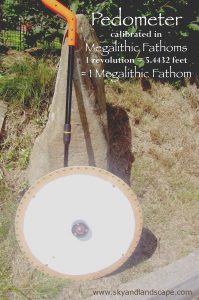
This distance, of 1988ft, may also be confirmed by using Google Earth. 1988ft divided by 5.4432 ft (1 megalithic fathom) delivers 365.226, a figure which it would be very hard – especially for someone in the act of celebrating the solstice alignment at Stonehenge – not to understand as having something to do with the yearly day count!
Radius = 10441.7 ft [centre Stonehenge to centre Pit Circle]
Diameter = 20,883.4ft
Circumference = 65,607.1 ft = 1988ft x 33 = 12053 MF = 365.2422 x 33 MF
The distance between each division of the circle, shown above around the perimeter = 365.2422 MF = one Solar Year
The main implications that emerge from this research supports that there may once have existed an outer circle, of 33 equally spaced posts, stones or holes, each spaced 1988ft apart (365.2422 MF), at a radial distance of 10,441.7 feet from the centre of Stonehenge. One of these markers is identified as the centre of the forming circle of the Durrington Walls pit circle, as previously described in this article.
As yet hypothetical, this 33 year circle surrounding Stonehenge, whose diameter is 20,883.4 ft, and whose circumference also passes through the centre of the Durrington Wall pit ring, has just come on the market as an investigable artefact, to perhaps become recognised, using the more familiar and traditional archaeological methods.
In the meantime that it is even possible that the rope that had originally been used to calibrate the circumference into 33 divisions of one year was the very same rope as had been used to define the length of the Stonehenge avenue – or vice versa!
Conclusions
The aim of this two-part article has been to show how geometry and metrology can be used to further a better understanding of prehistoric intentions and capabilities. A consistency of metrological practice has been identified, and a methodology developed and applied effectively. If, after all that has been discussed in this article, no basis for such a circular structure can be discerned or identified, or is thought not to be credible, then that in itself places the reader into a situation that stretches credibility far beyond anything required to recognise the implications arising from the evidential data provided here.
Robin Heath,
Carnedd Meibion Owen, July 19th 2020
Please Note: Part Three of this article will follow on in due course.
”
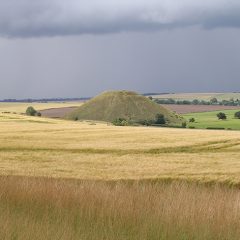
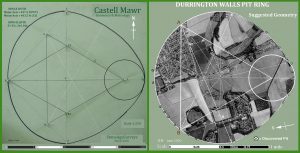
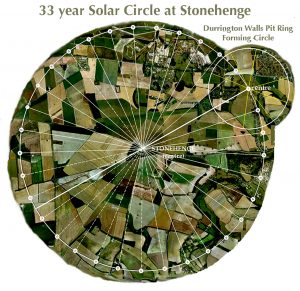
One thought on “Durrington Walls Pit Ring – Part Two”
Comments are closed.